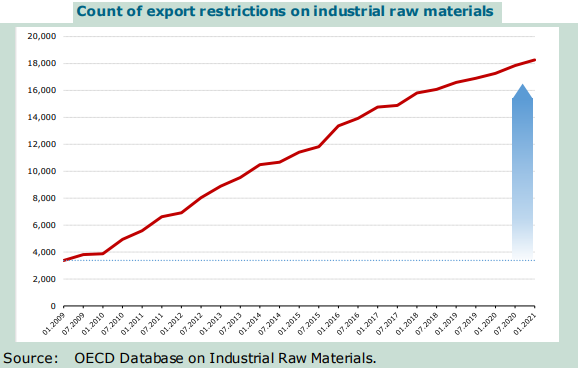Export restrictions on critical raw materials have increased more than fivefold in the last decade, the World Trade Organization (WTO) reported Tuesday.
Given widespread demand and concentrated supply, international trade will play a key role in meeting the rapidly growing demand for critical raw materials (CRMs), such as rare earth minerals, lithium, cobalt and nickel, which are essential for renewable energy and digital technologies.
This is especially the case in the short to medium term, as the expansion of new mining capacities and the recycling of CRMs take time to become operational.
In fact, between 2007-09 and 2017-19, the value of CRM trade expanded faster than overall merchandise trade, growing 38% (versus 31% for all merchandise trade).
This average also masks significant peaks, with lithium trade increasing by 438 percent, and ores and minerals trade by 57 percent.

In this context, the increasing use of export restrictions on CRMs recently documented by the OECD is cause for concern, the WTO said.
Export Restrictions
The OECD’s database on export restrictions on raw materials, which is updated annually, shows that export restrictions on CRMs have increased fivefold since the OECD began collecting data in 2009, and that 10% of global CRM trade now faces at least one export restriction measure.
Export restrictions on ores and minerals – the commodities upstream in CRM supply chains – grew faster than restrictions in the other segments of the CRM supply chain.
This correlates with the increasing concentration of production, imports and exports. Export taxes contributed the most to the global increase in export restrictions and became the most used type of restriction in 2020.
The above may be related to the fact that, according to WTO rules, quantitative export restrictions are usually prohibited, while export taxes are not.
Export restrictions on raw materials undermine the economic viability – and thus reduce production – of domestic extractive industries and benefit domestic end-users of these materials to the detriment of foreign users.
Export taxes or quantitative export restrictions, such as export quotas or even bans, can also contribute to higher world market prices for the CRMs in question, especially if the exporter has a large market share.
Such restrictions also create incentives for other producing countries to introduce similar restrictions, putting even greater upward pressure on international prices and in turn increasing incentives to restrict exports.

